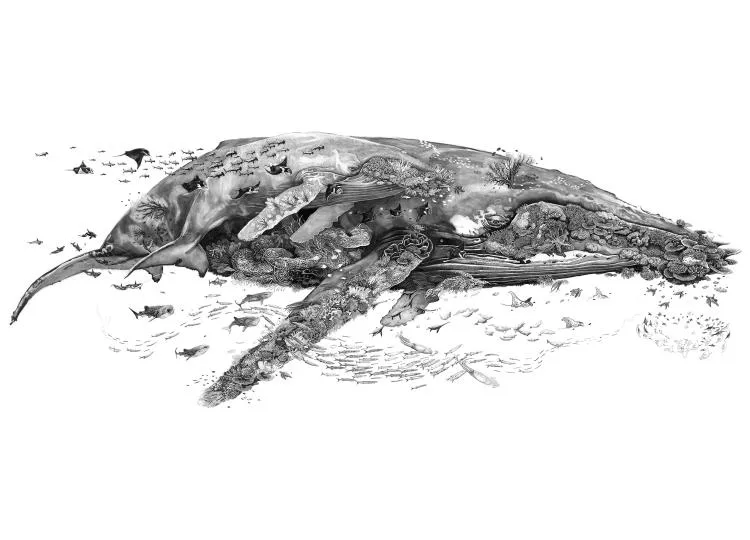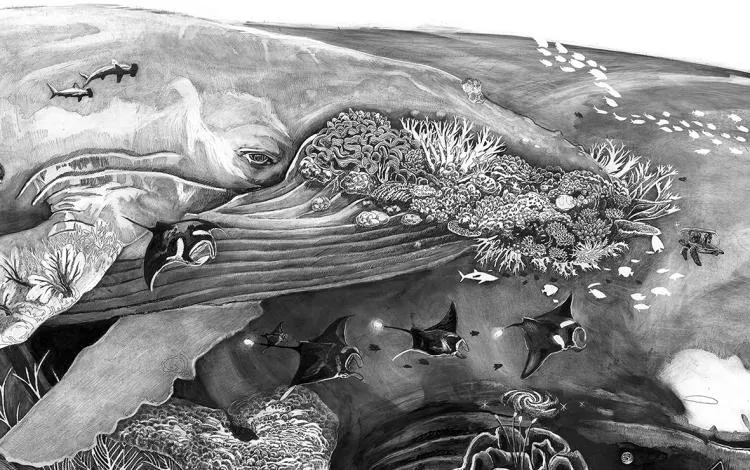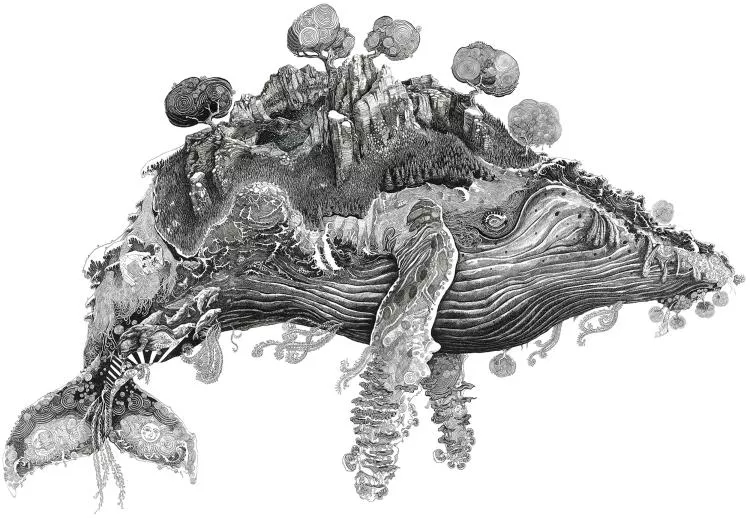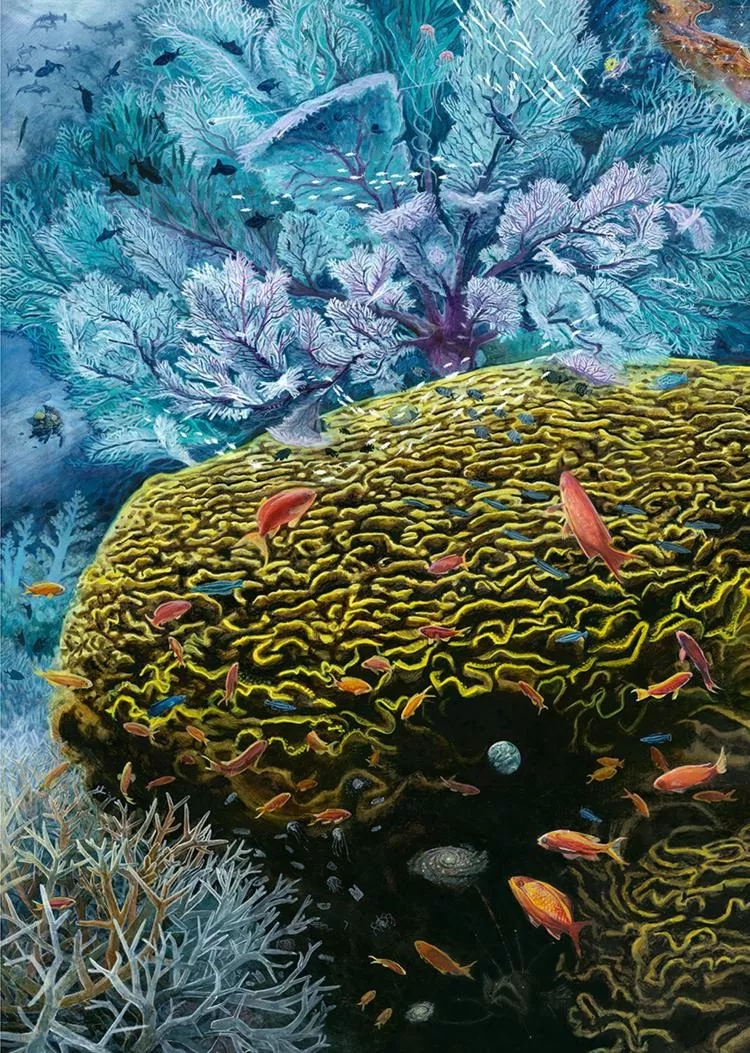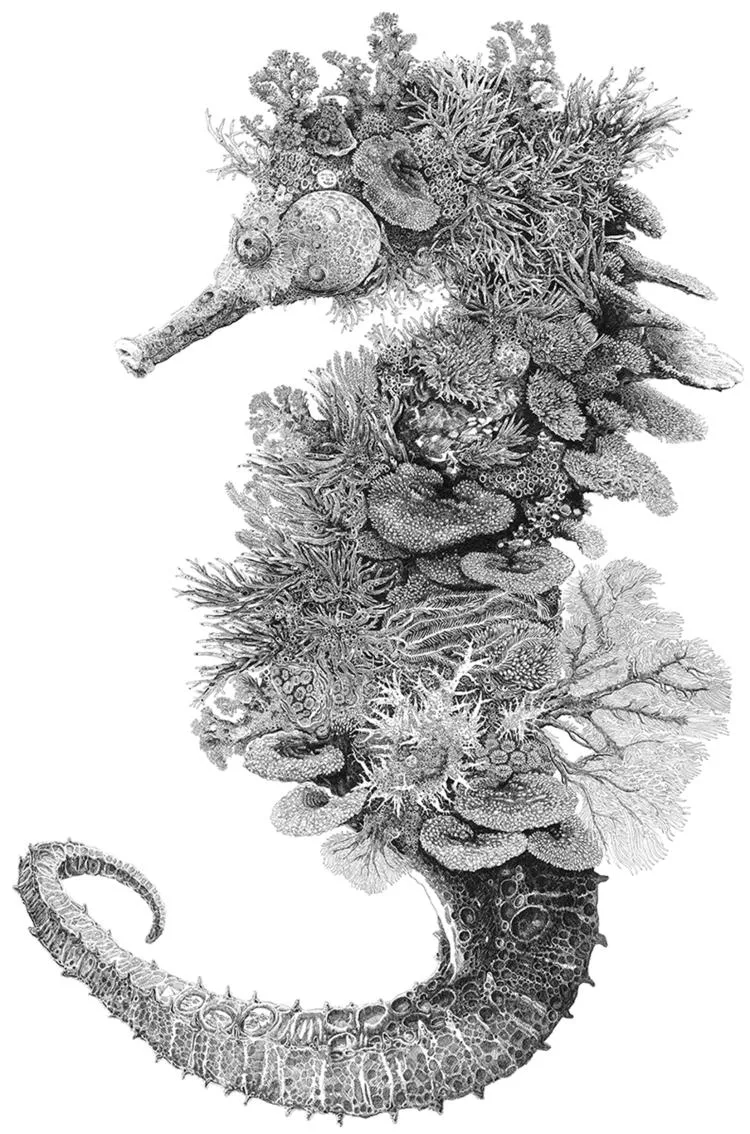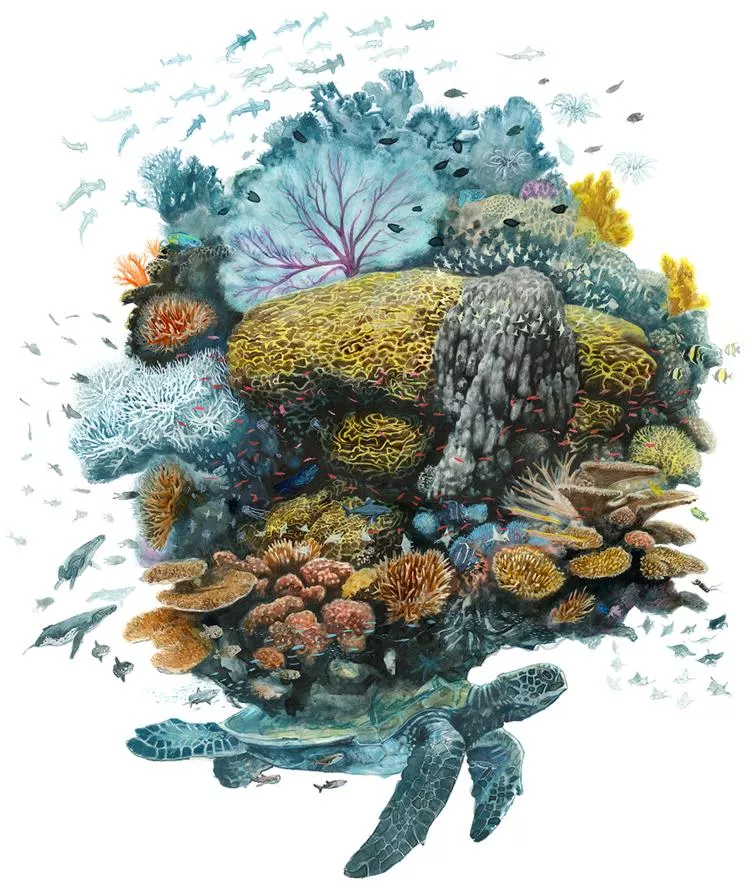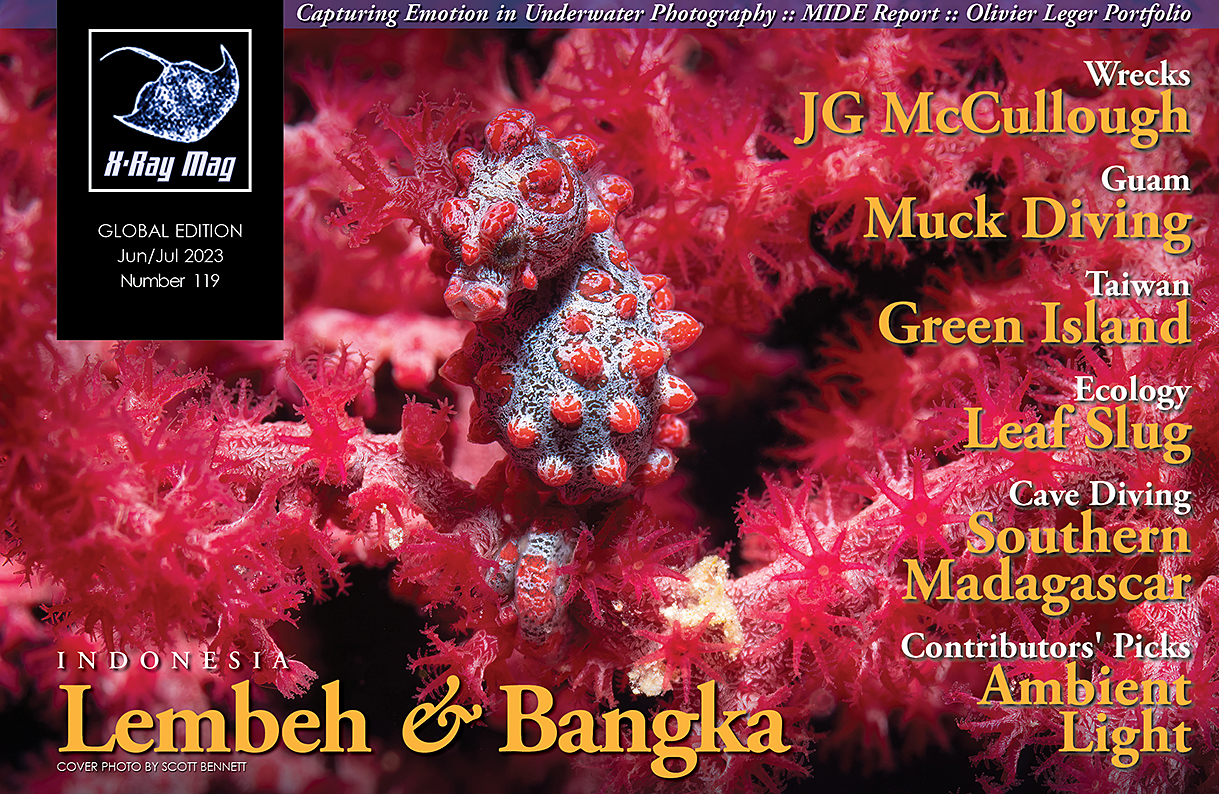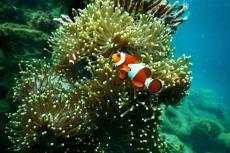British artist and avid diver Olivier Leger creates large-scale fineliner pen drawings and colourful ink paintings that celebrate the diversity and interconnectedness of our blue planet, drawing attention to the threats the oceans face. In his highly intricate artworks, viewers will discover marine species such as octopuses, sea turtles and whales carrying living worlds on their backs, giving sanctuary to a diverse range of sea life. X-Ray Mag interviewed the artist to learn more about his creative process and perspectives on the underwater world.
Contributed by
X-RAY MAG: Tell us about yourself, your background and how you became an artist.
OL: From a young age, I found it easier to explore the world and my ideas through images rather than words. After graduating with a fine arts degree, I found my interest and concern for the natural world finding its way into the drawings I made.
Entering one of my drawings into a local art competition was the catalyst to an unexpected career, and this year, I count myself very fortunate to mark 10 years as a full-time artist.
I work from a home studio in Leicestershire, United Kingdom, and exhibit regularly at art fairs and exhibitions around the country.
X-RAY MAG: Why marine life and underwater themes? How did you come to these themes and how did you develop your style of painting and drawing?
OL: It started with an interest in the interconnectedness of ecosystems and all life on Earth, which over time focussed into a fascination with marine ecology. The more I learnt about life in our oceans, the more it turned my understanding of the world on its head.
The bizarre creatures and strange phenomenon uniquely found in our oceans broadened my perceptions of life on our planet. An example is siphonophores—I saw a Portuguese man o’ war last year in the Azores, and it was mind-blowing to think that this creature in front of me was not, in fact, one organism but a whole colony of organisms, working so closely together that they act as one! Then, learning about underwater salt lakes changed my perspective of the ocean as a complex system, rather than just a volume of water that covers the surface of our planet.
My artwork explores this ocean world, full of surprise and mystery, and always offering something new to discover. The drawings and paintings are complex and intricate, drawing on my understanding of the web of ecosystems that encompasses our whole world.
My art is a direct reflection of the fact that on our one planet, everything is connected.
X-RAY MAG: Who or what has inspired you and your artwork and why?
OL: I am inspired by people who use their skills and their platforms to give Nature a voice, including the nature documentary makers who bring the extraordinary beauty of our planet right into our living rooms, making it so accessible for us to learn. They are the reason I became fascinated with our oceans, long before I ever dived and experienced it for myself.
I am also motivated by the growing community of “artivists” around the world. I find it encouraging to see how different artists create and use art as a tool for conservation.
The Japanese artist Ikeda Manabu is also an inspiration. His colossal, astounding pen-and-ink artworks show me what is possible to create if you dedicate your time, energy and skill to it.
X-RAY MAG: What is your artistic method or creative process?
OL: I start with the idea of an ocean animal as an “Ecological Godzilla”—a great whale, a turtle or an octopus… These animals bear ocean worlds on their backs. On them, coral reefs and vibrant habitats have established themselves, providing a sanctuary for the marine life of our world. Into that ocean world, I paint all the marine wildlife making their homes in these ecosystems, from cowfish to colossal squid and from sharks to seahorses.
With each artwork, I am attempting to create a symbol. A symbol that illustrates the wonders, biodiversity and interconnectedness of our ocean, but also holds up a mirror to the reality of the state of our ocean. Treading that thin line between celebrating our oceans and communicating the issues drives my whole process.
I do research to understand the animals, the marine ecosystem and the issues. Then, thinking through how to communicate all of that through images is not straightforward, when the issues are so complex, intangible and abstract as changing ocean currents or ocean acidification.
Hiding tiny details within my artworks encourages people to take a closer look. So, in a painting, I will include many tiny scenes, such as some penguins making their escape from a pod of orcas.
Working in fine-tipped pens or very fine paintbrushes with ink enables me to achieve the tiniest details. I have recently made the switch to colour painting in order to better capture the vibrancy and intricacy of coral reefs and marine life. And I have fun hiding some unexpected details. For example, you will almost always find a scuba diver exploring somewhere in my paintings!
X-RAY MAG: What is your relationship to the underwater world and coral reefs? Are you a diver or snorkeller? How have your experiences underwater influenced your art? In your relationship with reefs and the sea, where have you had your favourite experiences?
OL: I am very fortunate to have experienced the ocean by diving. It helped me realise that there is a whole other world hidden under the waves. We are really a planet of two worlds, the land and the ocean. It has given me a new understanding and appreciation for this great wilderness on our planet that is so full of life.
Each dive changes the way I approach my artwork, whether that be composition or content, in inexplicable ways. Whilst diving, I take photos and videos to use as reference images back in the studio.
Diving also helps keep me grounded in reality. It keeps my eyes open to the developing problems, such as coral bleaching, plastic pollution and algal blooms, that are otherwise hidden under the beautiful waves.
My most memorable underwater experience was meeting an inquisitive octopus on a dive off the Azores. As I steadied myself in the current by pinching on a rock, to stop and watch an octopus resting on the rock shelf for a while, it reached out a tentacle, a sensation which took me aback at first! I was lucky to stay with it for a few minutes whilst it explored my hand. It was fun and exciting to interact with another creature that seemed as interested in me as I was in it, and the experience helped me appreciate their intelligence and curiosity.
X-RAY MAG: What are your thoughts on ocean conservation and coral reef management and how does your artwork relate to these issues?
OL: It is clear to me that we are at a critical juncture, where the decisions and actions we take now will determine the fate of the planet. We are seeing and experiencing the devastating impact of the changes we are causing to the Earth’s systems. But science tells us that we can stem the tide, if we transform humanity’s relationship with the natural world and put our planet first.
We have the opportunity to protect our natural world, to preserve its beauty and its wonders, and also the vital function it offers us (if you want to see it from a human-centric perspective) and all life we share Earth with.
Our oceans are the largest ecosystem on the planet and supports every single living being on it. When I started off as an ocean artist a decade ago, I wanted to celebrate the wonder of life in our oceans through my artwork, in the hope that it would inspire a desire to protect them. I shied away from addressing the negatives because I thought it would turn people off. But I am at the point now where that is no longer good enough, and I am now addressing these issues directly in my artwork.
We still have a beautiful world with so much to be grateful for and so much worth fighting for, and I want to celebrate that. But in order to respect the ocean, I also need to reflect these issues in my compositions. I am trying to capture the moment in time we find ourselves in, to paint things as they are, the good and the bad.
As a small creative business, I am committed to operating as environmentally friendly and sustainably as I can. For example, I source materials for my prints, products and packaging to avoid, where possible, the use of virgin, single-use and non-recyclable materials. And every print purchased plants a mangrove tree through Only One. I realise it’s not perfect, and I am continually looking for ways to improve.
X-RAY MAG: What is the message or experience you want viewers of your artwork to have or understand?
OL: I hope that some will walk away from my artworks with a renewed appreciation for our blue planet, and maybe even a new idea, question or perspective on their relationship with it.
I hope that people have fun exploring my drawings and paintings, that they make them smile, and that they discover something new. And I hope that the artwork promotes dialogue, change and action.
X-RAY MAG: What are the challenges or benefits of being an artist in the world today? Any thoughts or advice for aspiring artists in ocean arts?
OL: I think the biggest challenge and opportunity artists, and especially ocean artists have, is to use our artwork to say something. In order to communicate effectively, the challenge is striking that delicate balance between creating engaging, approachable artwork whilst also addressing the issues.
My other advice is to think outside the box for ways to reach audiences with your artwork. Of course, social media provides a great platform to reach an international audience. Also consider non-traditional institutions and opportunities to reach people from all walks of life with art.
X-RAY MAG: How do people—adults and children—respond to your works?
OL: It is really fun watching people discovering all the little details hidden in my artworks, when they spot their favourite animal, or something unexpected like a plesiosaur or a treasure chest, and their faces light up. Kids are great explorers; they are curious and not inhibited by preconceptions of art.
I often hang magnifying glasses alongside my work as an invitation for someone to pick one up and take a closer look. It’s like “Where’s Wally?” but with whales… “Where’s Whaley?!”
X-RAY MAG: What are your upcoming projects, art courses or events?
OL: I have just started my largest, most ambitious painting to date! Atlas is a 2.1 x 1.8m painting of a turtle bearing a coral reef on her back.
I will be painting a coral reef full of biodiversity, with a wonderful multitude of animals living within and around her, from great whale sharks to the tiniest cowfish. I will also be painting the issues, like coral bleaching and plastic pollution. And I will be addressing less tangible issues such as shifting baselines, or environmental generational amnesia, the idea that what we consider to be a healthy environment now, past generations would consider to be degraded, and what we consider to be degraded now, our children will consider to be healthy or “normal.”
Painting Atlas is my effort to tell the story of the challenges and opportunities facing our blue planet at this moment in time and help protect the ocean that I love.
I anticipate Atlas will take me 18 months to complete. I will share photos of my progress on my social media, so please follow me to see it come to life over the coming months.
You can also watch ATLAS, a short documentary which follows my journey over the summer of 2022, as I embark on painting Atlas. Throughout it, I grapple with my role as an ocean wildlife artist and whether art can inspire change. You can watch it for free on my YouTube channel (youtu.be/QxSa0DUK9gg).
X-RAY MAG: Lastly, is there anything else you would like to tell our readers about yourself and your artwork?
OL: I am a wannabe marine biologist at heart, keen to learn more about marine life and the opportunities and challenges facing them, so that I can better communicate them through my artwork. So, if you have got a research or conservation project that I could get involved in, I would love to hear from you! ■
For more information or to purchase prints, please visit the artist’s website at: olivierleger.com, or follow him on Instagram at @olivier_leger. To see the documentary video about the artist’s work ATLAS, go to: youtu.be/QxSa0DUK9gg


